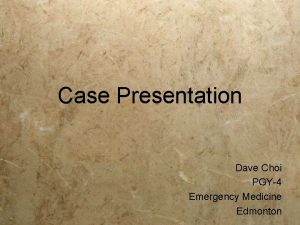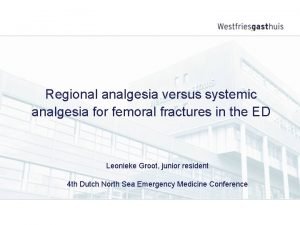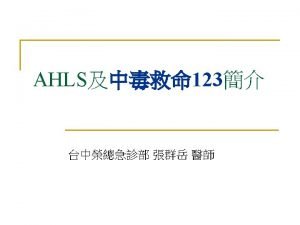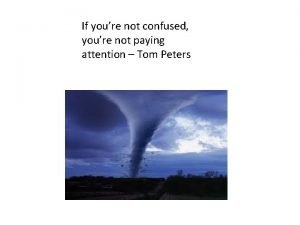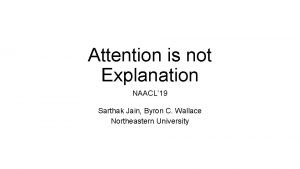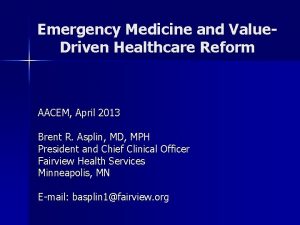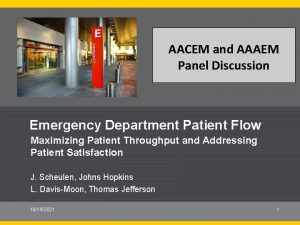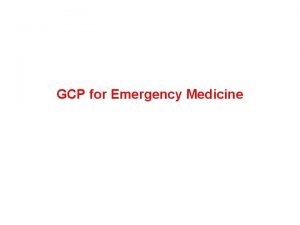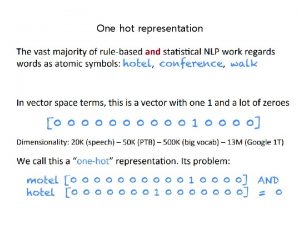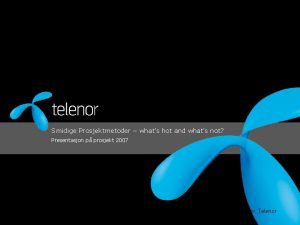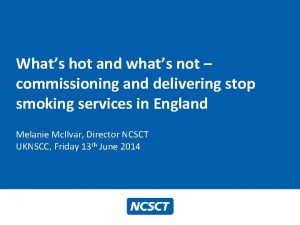Whats Hot Whats Not in Emergency Medicine AACEM
















- Slides: 16

What’s Hot & What’s Not in Emergency Medicine AACEM Panel February 2016 Jay Kaplan, M. D. , FACEP

What’s Hot • Physician Burnout • “Surprise” Bills and attempts to Ban Out of Network Balance Billing • Pay for Performance/Value-based reimbursement • Opioid Use Epidemic • Mass Casualty Incidents • Focus on Quality • Diversity

What’s Not • What brought us to this dance isn’t getting us into the next one. • The Future is ahead of schedule. • Fair payment • Safe harbors • Increased GME funding

Physician Burnout • Emergency medicine leads all specialties in frequency. • Wellness Week TM

5

OON Balance Billing • Anthem VP – “The first and only thing which people look at is the affordability of the premium. ” • Change the talk from “Surprise Billing” to “Surprise Coverage” • Talk about fair coverage for our patients rather than fair payment for physicians. • “Insurance companies care more about their profits than they do our patients. ” • Considering initiation of legal action against CMS and CCIIO regarding the final rule on GOT.

OON Balance Billing/P 4 P & VM • Joint Task Force with EDPMA and ACEP Medicaid Task Force to create a toolbox including model legislation and best practices • Working with American Society of Anesthesiologists and American College of Radiology • Task Force on APM’s with consultants to create alternative payment models for emergency medicine

Opioid Epidemic • White House Working Group • PCORI workshop • Working to expand the model of EDIE which has been so successful in Washington • Letter to CMS/HHS regarding removing pain questions from CAHPS surveys • Letter to TJC regarding removing pain as the “ 5 th vital sign” • Pain Management ACEP section

Mass Casualty Incidents • New High Threat High Casualty Task Force • White paper detailing current national efforts, recommended clinical practice guidelines for adults and pediatric patients, and future strategy for ACEP engagement as a national leader in the area of high threat emergency care. • Identify best practice recommendations for provision of care in high threat environments. • Identification of clinical and operational knowledge gaps and articulation of future research objectives. • Serve as advisory body for the ACEP Board for information sharing for planning and during evolving, acute high threat incidents.

Diversity • Recognition of the need to increase diversity in current and future leadership • April 14 – Diversity Summit – 25 current and future leaders in emergency medicine will meet in Dallas

ACEP Emergency Quality Network • CEDR – validating our own quality metrics • CMS Transforming Clinical Practice Initiative: The TCPI is designed to help clinicians achieve largescale health transformation o Support >140, 000 clinician practices over the next 4 years o Sharing, adapting and further developing their comprehensive quality improvement strategies. o Preparing to adopt alternate payment methods • ACEP is one of 39 health care organizations selected to participate in the CMMI TCPI o One of 10 Support and Alignment Networks (SAN)

EM Focus Areas 1. Improving outcomes for patients with sepsis 2. Reducing avoidable imaging in low risk patients through implementation of ACEP’s Choosing Wisely recommendations • Reduce use of high-cost imaging for low back pain • Head CT scan after minor head injury • Chest CT for pulmonary embolus • Abdominal CT for renal colic 3. Improving the value of ED chest pain evaluation in low risk patients by reducing avoidable testing and admissions

What will the Learning Collaboratives provide? Recruitment & Enrollment Pledge Readiness Assessment Survey Participation Sign Up Learning Period (6 -9 months) Monthly Webinars Introduction to tool kit Publicize guidelines and materials Disseminate CME Benchmarking data Office Hours Wrap Up Data Reports Summary Report Lessons Learned e. CEM & MOC credit Achieve CMS PQRS requirments Re-enrollment

How to Participate • Pledge to join the Emergency Quality Network • Take the Emergency Quality Network Readiness Assessment • Sign-up for one or all of the Emergency Quality Network learning collaboratives

Questions • How can ACEP best partner to support EDs in advancing performance improvement in these topics? – What can ACEP do to support your academic departments? • What does a project that is appealing to your departments look like? o Why would your EDs join? What barriers exist to joining? o What compliments current or planned QI activities? • Do some topics resonate more than others?

Additional Thoughts • • New HQ Building Our commitment to EM Residency site visits Leadership & Advocacy Conference Key words for us – Tactical – it’s not just about ideas it’s about implementation – Collaborative – we are better together than apart
 Whats hot whats not
Whats hot whats not Cmc vellore handbook of emergency medicine
Cmc vellore handbook of emergency medicine Emergency medicine case presentation
Emergency medicine case presentation Dutch north sea emergency medicine conference
Dutch north sea emergency medicine conference Unm emergency medicine residents
Unm emergency medicine residents University of arizona emergency medicine
University of arizona emergency medicine Vocab level d unit 3
Vocab level d unit 3 White hot vs red hot temperature
White hot vs red hot temperature Cold working processes
Cold working processes Perbedaan hot lava dan hot lava volcano
Perbedaan hot lava dan hot lava volcano Hot nor hot
Hot nor hot Hot or not composite images
Hot or not composite images Do not make friends with a hot tempered man
Do not make friends with a hot tempered man If you're not confused you're not paying attention
If you're not confused you're not paying attention Casual informal style
Casual informal style Attention is not not explanation
Attention is not not explanation Not too broad and not too narrow
Not too broad and not too narrow


